|
|
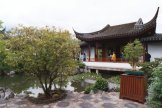 The
high-ceilinged main
hall, called the China-Maple Friendship Hall, was
built without nails from four different Chinese woods. The
high-ceilinged main
hall, called the China-Maple Friendship Hall, was
built without nails from four different Chinese woods. |
 One of the miniature potted trees near the China-Maple Friendship Hall. One of the miniature potted trees near the China-Maple Friendship Hall. |
|
|
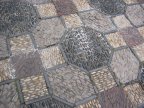 Detail
of the courtyard floor at the China-Maple Friendship Hall. Water worn pebbles, in combination with bits of quarried stone, broken pottery, and
roof tiles set on edge, are used extensively in walkways and paved
courtyards in a wide variety of patterns. The mosaic pattern on each courtyard is different. Detail
of the courtyard floor at the China-Maple Friendship Hall. Water worn pebbles, in combination with bits of quarried stone, broken pottery, and
roof tiles set on edge, are used extensively in walkways and paved
courtyards in a wide variety of patterns. The mosaic pattern on each courtyard is different. |
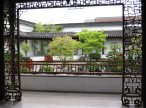 View
of the Courtyard in front of the China-Maple Friendship
Hall. View
of the Courtyard in front of the China-Maple Friendship
Hall. |
|
|
 The garden is noted for its
prolific use of fantastically shaped stones. The extravagantly
convoluted limestones are sometimes displayed singly on a base like a
piece of sculpture. They are prized for their four virtues which are:
the holes that allow life force to flow freely, the rough texture, their
slenderness, and being top-heavy. The hardy banana is planted under the eaves in
order to take advantage of the sound of rain dripping from the roof and
falling on their large leaves. The garden is noted for its
prolific use of fantastically shaped stones. The extravagantly
convoluted limestones are sometimes displayed singly on a base like a
piece of sculpture. They are prized for their four virtues which are:
the holes that allow life force to flow freely, the rough texture, their
slenderness, and being top-heavy. The hardy banana is planted under the eaves in
order to take advantage of the sound of rain dripping from the roof and
falling on their large leaves. |
 Limestone
rock
formation in the Scholar's Courtyard. Stone is the hard skeletal
structure of the world. It's used in a garden in two important ways: as
sculpture and as building material. The most prized of all the strangely
shaped standing stones are Taihu stones. Formed of limestone
brought up from the bed of Lake Tai, only thirty kilometers west of
Suzhou, they demonstrate, over the course of many years, the soft force
of water as it wears away hard stone. They line the edges of garden
ponds, are piled into false mountains, and are set up as monolithic
abstract sculpture. Limestone
rock
formation in the Scholar's Courtyard. Stone is the hard skeletal
structure of the world. It's used in a garden in two important ways: as
sculpture and as building material. The most prized of all the strangely
shaped standing stones are Taihu stones. Formed of limestone
brought up from the bed of Lake Tai, only thirty kilometers west of
Suzhou, they demonstrate, over the course of many years, the soft force
of water as it wears away hard stone. They line the edges of garden
ponds, are piled into false mountains, and are set up as monolithic
abstract sculpture. |
|
|
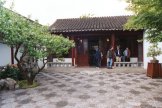 A
Scholar's
Study faces a small private courtyard adjacent to the main
garden area and linked by the footpath. Traditional arts including
calligraphy, landscape painting, music and poetry would have been practiced
in this area by the owner of the garden. In a corner of the scholar's
garden, there stands the one tree that every classical garden must
contain -- a winter-flowering plum representing youth in its flowers and
old age in its trunk. A
Scholar's
Study faces a small private courtyard adjacent to the main
garden area and linked by the footpath. Traditional arts including
calligraphy, landscape painting, music and poetry would have been practiced
in this area by the owner of the garden. In a corner of the scholar's
garden, there stands the one tree that every classical garden must
contain -- a winter-flowering plum representing youth in its flowers and
old age in its trunk. |
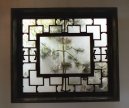 Plants
in the Garden have symbolic significance. In the Scholar's Study, three windows
frame trees are named "The Three Friends of Winter". The three
"living pictures" of plants are enclosed within small
open-topped spaces set behind interior windows in the Scholar's Study.
Every window has a different design. The pine tree shown
here symbolizes fortitude and long-lasting friendship. Plants
in the Garden have symbolic significance. In the Scholar's Study, three windows
frame trees are named "The Three Friends of Winter". The three
"living pictures" of plants are enclosed within small
open-topped spaces set behind interior windows in the Scholar's Study.
Every window has a different design. The pine tree shown
here symbolizes fortitude and long-lasting friendship. |
|
|
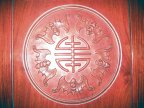 Detail
of the five bat engraving on one of the small tables in the Scholar's study.
Bats symbolize happiness and
longevity. The design of the five bats stands for the Five Blessings:
long life, wealth, health, love of virtue, and natural death. Five is
also an important number in the design of a Suzhou style garden because
it denotes the five elements of a garden: architecture, plants, rocks,
water, and poetry. Detail
of the five bat engraving on one of the small tables in the Scholar's study.
Bats symbolize happiness and
longevity. The design of the five bats stands for the Five Blessings:
long life, wealth, health, love of virtue, and natural death. Five is
also an important number in the design of a Suzhou style garden because
it denotes the five elements of a garden: architecture, plants, rocks,
water, and poetry. |
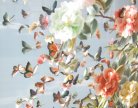 Detail
of the amazing embroidery on a silk room divider in the Scholar's study. Detail
of the amazing embroidery on a silk room divider in the Scholar's study. |
|
|
 The
entrance to the garden from the attached Chinese home was through this
type of door. The owners of these gardens were scholars, among the
best-educated in China.
The
entrance to the garden from the attached Chinese home was through this
type of door. The owners of these gardens were scholars, among the
best-educated in China. |
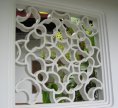 Windows filled with decorative
patterns are known as "leak
windows" since they leak a little of the view, and some of the
light, through from the other side. Each leak window in the Garden is
unique.
Windows filled with decorative
patterns are known as "leak
windows" since they leak a little of the view, and some of the
light, through from the other side. Each leak window in the Garden is
unique. |
|
|
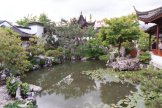 In
the west we speak of planting a garden, the Chinese think of building
one. Rather than imitate nature, the Chinese gardener tries to recreate
an ideal landscape in miniature with mountains, lakes, trees, and their qi,
or energy, and to incorporate man's place within nature. In
the west we speak of planting a garden, the Chinese think of building
one. Rather than imitate nature, the Chinese gardener tries to recreate
an ideal landscape in miniature with mountains, lakes, trees, and their qi,
or energy, and to incorporate man's place within nature. |
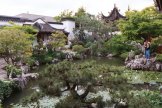 The
object of the garden is to capture all the elements of the natural
landscape -- mountains, rivers, lakes, trees, valleys, hills -- and, by
bringing them together in a small space, to concentrate the life force,
the qi, that animates them. The
object of the garden is to capture all the elements of the natural
landscape -- mountains, rivers, lakes, trees, valleys, hills -- and, by
bringing them together in a small space, to concentrate the life force,
the qi, that animates them. |
|
|
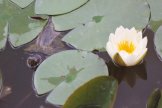 Turtles
and lotus flowers live in the jade water at the Garden. The lotus is a
traditional sign of purity and perfection. Turtles
and lotus flowers live in the jade water at the Garden. The lotus is a
traditional sign of purity and perfection. |
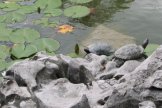 More
turtles at the
Garden. More
turtles at the
Garden. |
|
|
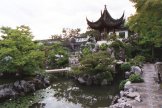 The crooked, mosaic stone path through the garden zigzags because evil
spirits can only follow a straight line. It also provides ever-changing
views of the small 1/3-acre garden. The crooked, mosaic stone path through the garden zigzags because evil
spirits can only follow a straight line. It also provides ever-changing
views of the small 1/3-acre garden. |
 Grisel
standing on a Qiáo (bridge) near the pavilion. There
are four major elements in the Garden: water, rock, plants and
architecture. The relationship of these four elements reflect the Taoist
belief in Yin and Yang -- opposites that must be in balance to create
harmony. [ Grisel
standing on a Qiáo (bridge) near the pavilion. There
are four major elements in the Garden: water, rock, plants and
architecture. The relationship of these four elements reflect the Taoist
belief in Yin and Yang -- opposites that must be in balance to create
harmony. [ |
|
|
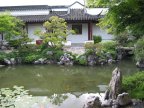 Side
view of the Scholar's Study. All
of the buildings face south, for sunlight and because enemy Mongols came
from the north. Without
colorful plantings to distract attention from the essential design, the
simple features of the four major elements combine to create what the Chinese call a "living
treasure." Side
view of the Scholar's Study. All
of the buildings face south, for sunlight and because enemy Mongols came
from the north. Without
colorful plantings to distract attention from the essential design, the
simple features of the four major elements combine to create what the Chinese call a "living
treasure." |
 Classical
Chinese gardens contain plants known for their mystical and symbolic
qualities. Plants in
the
Garden are used sparingly and each one
is selected for its symbolic meaning and its ability to evoke a natural
landscape. Classical
Chinese gardens contain plants known for their mystical and symbolic
qualities. Plants in
the
Garden are used sparingly and each one
is selected for its symbolic meaning and its ability to evoke a natural
landscape. |
|
|
 The
Tíng - a pavilion, or literally 'stopping' place in which to
rest. The Chinese philosophy of yin and yang are also evident here. In
the shade of the pavilion you are experiencing Yin, while Yang is
demonstrated by the sunshine. The wetness of the water is Yin while the
dryness of the land is yang. The softness of the plants is Yin, while
the hardness of the rocks is Yang. This balance of yin and yang reflects
the balance of nature.
The
Tíng - a pavilion, or literally 'stopping' place in which to
rest. The Chinese philosophy of yin and yang are also evident here. In
the shade of the pavilion you are experiencing Yin, while Yang is
demonstrated by the sunshine. The wetness of the water is Yin while the
dryness of the land is yang. The softness of the plants is Yin, while
the hardness of the rocks is Yang. This balance of yin and yang reflects
the balance of nature. |
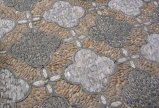 Detail
of one of the elaborate hand-laid courtyard floors. The mosaic floors
are created from tiles made from a combination of
smooth pebbles and broken rice bowls. Detail
of one of the elaborate hand-laid courtyard floors. The mosaic floors
are created from tiles made from a combination of
smooth pebbles and broken rice bowls. |
|
|
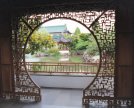 The Moon Gate looks out into the duck pond and pavilion
in the Chinese-style Vancouver city park adjoining the classical Chinese garden. The Moon Gate looks out into the duck pond and pavilion
in the Chinese-style Vancouver city park adjoining the classical Chinese garden. |
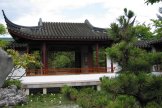 The
Moon Gate
as seen from the classical Chinese garden. The hand-fired roof tiles,
carved woodwork, lattice windows, limestone rocks and pebbles create an
authentic area of peace and calm in the midst of a bustling and busy
neighborhood. The
Moon Gate
as seen from the classical Chinese garden. The hand-fired roof tiles,
carved woodwork, lattice windows, limestone rocks and pebbles create an
authentic area of peace and calm in the midst of a bustling and busy
neighborhood. |
|
|
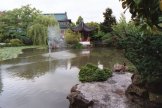 View
of the duck pond and pavilion in the adjoining Chinese-style Vancouver city park from the Classical Chinese Garden. View
of the duck pond and pavilion in the adjoining Chinese-style Vancouver city park from the Classical Chinese Garden. |
 Canadian
goose hanging out in the Classical Chinese Garden. Canadian
goose hanging out in the Classical Chinese Garden. |
|
|
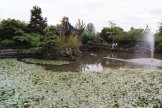 In
the Chinese-style Vancouver city park next door to the garden, residents
enjoy lunch among bamboo stands, ginkgo tree blossoms and oriental
volcanic rock. In
the Chinese-style Vancouver city park next door to the garden, residents
enjoy lunch among bamboo stands, ginkgo tree blossoms and oriental
volcanic rock. |
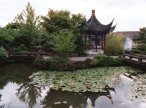 The
Chinese-style Vancouver city park. The
Chinese-style Vancouver city park. |
|
|